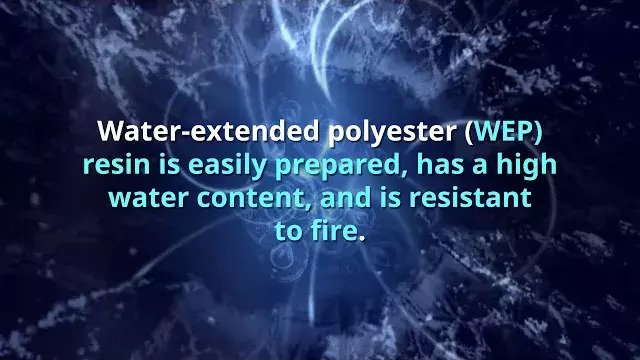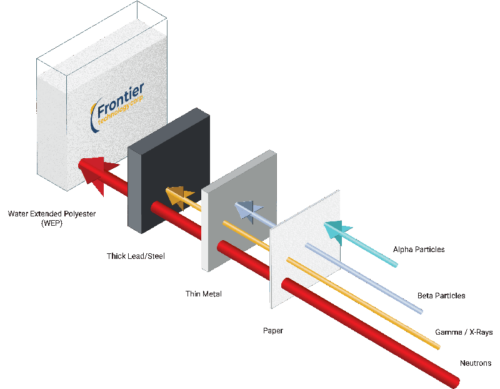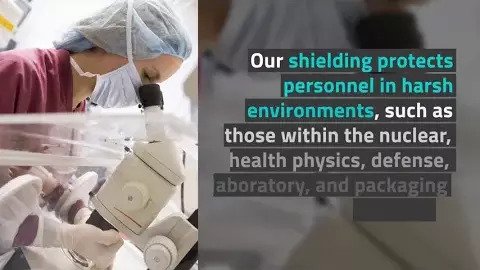
The Challenge of Neutron Radiation Shielding
Because neutron radiation endangers the people, structures, devices, and equipment exposed to it, reliable neutron shielding protection is critical. Specially designed shielding walls are used in nuclear power facilities, nuclear medicine systems, radioisotope projects, or particle accelerator work.
Many materials may be used to shield against ionizing radiation. However, the three most popular neutron shielding materials are WEP resin, paraffin, and concrete. Notably, dense materials, such as lead, are less effective at blocking neutron radiation and are not used for neutron shielding.
WEP Neutron Shielding
Hydrogen and hydrogen-based materials, such as water and water-extended polyester (WEP), are preferable for neutron shielding. This is because compounds with a high concentration of hydrogen atoms act as reliable barriers and provide inexpensive yet reliable shielding.
Frontier’s shielding walls incorporate materials made of low-atomic-number elements because they have a high probability of forming cross-sections that interact with the neutrons.
"*" indicates required fields
Why is Neutron Shielding Needed?
Cf-252 freely emits what are known as fast or fission energy neutrons. These fast neutrons have very high kinetic energy levels, close to 1 MeV (1.6×10−13 J) and a speed of ~14000 km/s. As a result, they move quickly and can penetrate most material easily, causing great harm to people and animals. Adverse health effects are seen especially in soft tissues and at the cellular level, in which cell function is altered or cellular reproduction is disabled entirely.
Fast neutrons can also penetrate solid objects, contaminating them and causing structural damage to equipment in the surrounding area. The damage occurs because neutrons move so quickly and transfer massive amounts of kinetic energy to the material they encounter at the atomic level. The material itself becomes radioactive after ongoing exposure.
Neutron Shielding Applications
Shielding is required any time a neutron source is in use or could come in contact with people. This includes shipping and transportation, short- or longer-term storage, as well as when the isotope is in use for nuclear or industrial applications.
Shielding containers and structures usually consist of a mix of materials that work together to block neutrons from escaping. Examples include:
- Steel shipping/storage containers filled with water-extended polymer resin (WEP)
- Shielding walls that incorporate concrete and panels filled with water
- Other steel boxes or enclosures with WEP resin or concrete fillings
Neutron Shielding Materials and Properties
The goal of shielding is to prevent neutrons from reaching people or objects in their path and to mitigate bodily harm and damage to equipment or structures. In order to stop a neutron, as much of its kinetic energy as possible must be transferred to another particle of similar mass. This reduces the speed at which the neutron travels or stops it outright, a process called thermalizing.
At the atomic level, hydrogen is the most effective material for shielding neutrons. This is because neutrons and protons have a similar mass, so when a neutron hits a single proton (e.g., a hydrogen nucleus), kinetic energy is transferred and the neutron slows or stops. Therefore, materials containing high levels of hydrogen tend to be the best to use for fast neutron shielding.
Heavy metals, such as lead, are not used in neutron shielding. The high density of lead means its nuclei are very heavy, far heavier than neutrons. As a result, instead of transferring their kinetic energy upon collision with lead nuclei, neutrons do not stop and continue to pass through the material. Another important element in shielding is boron, which readily absorbs neutrons.
Neutron Shielding Walls from Frontier
Frontier’s WEP resin is an ideal material for neutron radiation shielding because:
High Water Content: As a result of the emulsification process, WEP resin’s final hydrogen content is almost as high as that of pure water. Unlike water, WEP resin cures into a hard shield, so it can easily be used in almost any shielding application.
- Cost-Effective: WEP resin’s high water content makes it a very affordable substance by weight compared to alternative materials.
- Harsh Environmental Resistance: WEP is completely inert. It doesn’t break down and resists damage from water exposure, weathering, and harsh chemicals. WEP is also fire-retardant (although best-suited for normal operating temperatures).
- Void-Free Curing: WEP resin sets cleanly and with minimal imperfections and no odor. It cures as a contiguous solid material with no voids, holes, or bubbles.
Custom WEP Neutron Radiation Shielding Solutions
Our shielding walls are custom-manufactured to your requirements, constructed with stainless steel outer materials, and contain WEP inner material. Our neutron radiation shielding options include:
- Custom dimensions available
- Isotope pass-through ports
Frontier can also use WEP to fill shielding walls that our customers have designed and supplied to us.
Frontier's Custom Shield Wall Manufacturing Capabilities & Provisions
| Types: | Walls |
| Shielding | |
| Outer Material: | Stainless Steel |
| Inner Material: | Filled WEP (Water-extended polyester) |
| Thickness: | Custom Dimensions Available |
| Height: | Custom Dimensions Available |
| Width: | Custom Dimensions Available |
| Options: | Isotope Pass-Thru Ports |
| Production Volume: | Prototype |
| Production | |
| Testing Services: | Void Volume |
| Meter Testing | |
| Quality Control: | QA Manual |
| Additional Services: | Documentation |
| Integration | |
| Product Design | |
| Project Management | |
| Reverse Engineering | |
| Technical Support | |
| Project Lead Time: | 8-to-14 Weeks (based on inventory and scheduling) |
| Expedited Services Available |
About Frontier Technology Corporation
Frontier Technology Corporation (FTC) is the world leader in californium-252 neutron source manufacturing and design, and is the foremost expert in logistics and shipping of radioactive material. Founded in 1984 by Treva Janzow and the late Edward Janzow, Frontier Technology is located in Xenia, Ohio. Frontier Technology has over 40 years industry experience in providing the highest-quality neutron sources, PINS sources, nuclear start-up rods, TYPE-A shipping containers, WEP shielding, and antimony-beryllium pellets.
Type-A Neutron Shipping Containers
Frontier designs and fabricates “Type-A” shipping packages of various sizes, shielding, capacities, and configurations for use, rental, or purchase by our customers. All packages are designed and constructed in-house to ensure that the highest quality standards are met.
Type-A Shipping ContainersWEP: The Best Neutron Shielding Material
WEP resin is a newer shielding choice valued for water’s high hydrogen availability. Due to its high content of large, neutron blocking hydrogen molecules, WEP is a highly effective shielding material. It also contains boron, an element that absorbs neutrons and adds additional shielding capability. WEP resin is strong, versatile, durable, and offers better neutron shielding performance than some high-density options.
WEP: The Best Neutron Shielding MaterialNuclear Shielding Applications
Neutron radiation poses significant danger to people, structures, devices, and equipment exposed to it; therefore, effective neutron shielding is critical. In plants, labs, and other buildings where neutron sources and equipment are used, shielding walls are an excellent way to protect against neutron radiation.
Nuclear Shielding Applications
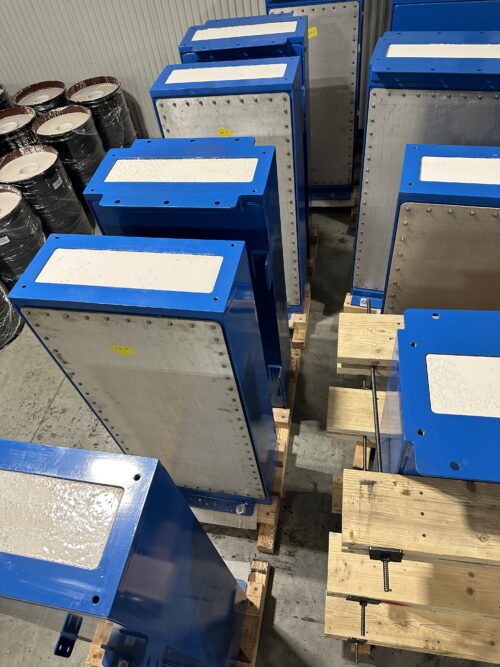
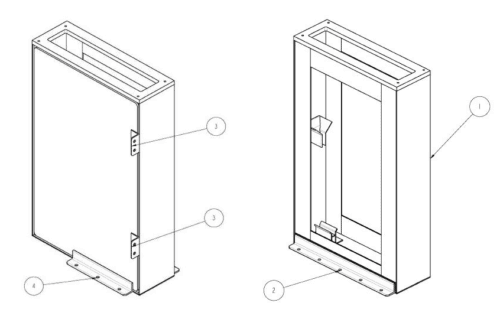 High Water Content: As a result of the emulsification process, WEP resin’s final hydrogen content is almost as high as that of pure water. Unlike water, WEP resin cures into a hard shield, so it can easily be used in almost any shielding application.
High Water Content: As a result of the emulsification process, WEP resin’s final hydrogen content is almost as high as that of pure water. Unlike water, WEP resin cures into a hard shield, so it can easily be used in almost any shielding application.